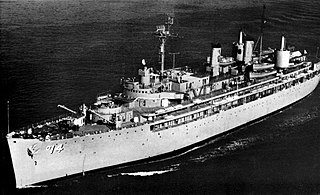The United States Navy, United States Coast Guard, and United States National Oceanic and Atmospheric Administration (NOAA) use a hull classification symbol to identify their ships by type and by individual ship within a type. The system is analogous to the pennant number system that the Royal Navy and other European and Commonwealth navies use.

A naval ship is a military ship used by a navy. Naval ships are differentiated from civilian ships by construction and purpose. Generally, naval ships are damage resilient and armed with weapon systems, though armament on troop transports is light or non-existent.

High-speed transports were converted destroyers and destroyer escorts used in US Navy amphibious operations in World War II and afterward. They received the US Hull classification symbol APD; "AP" for transport and "D" for destroyer. In 1969, the remaining ships were reclassified as "Fast Amphibious Transports", hull symbol LPR.

Destroyer escort (DE) was the United States Navy mid-20th-century classification for a 20-knot warship designed with the endurance necessary to escort mid-ocean convoys of merchant marine ships.

The Clemson class was a series of 156 destroyers which served with the United States Navy from after World War I through World War II.

The Wickes-class destroyers were a class of 111 destroyers built by the United States Navy in 1917–19. Along with the 6 preceding Caldwell-class and 156 subsequent Clemson-class destroyers, they formed the "flush-deck" or "four-stack" type. Only a few were completed in time to serve in World War I, including USS Wickes, the lead ship of the class.

USS Harding (DD-91) was a Wickes-class destroyer in the United States Navy during World War I. She was the first ship named in honor of Seth Harding.

The Captain class was the designation given to 78 frigates of the Royal Navy, constructed in the United States, launched in 1942–1943 and delivered to the United Kingdom under the provisions of the Lend-Lease agreement. They were drawn from two classes of the American destroyer escort classification: 32 of the GMT (Evarts) Type and 46 of the TE (Buckley) Type. Upon reaching the UK the ships were substantially modified by the Royal Navy, making them distinct from the US Navy destroyer escort ships.

An auxiliary ship is a naval ship designed to support combatant ships and other naval operations. Auxiliary ships are not primary combatant vessels, though they may have some limited combat capacity, usually for purposes of self-defense.

USS Samuel Gompers (AD-37) was a destroyer tender, the first of her class, and designed to be a floating repair shop for ships of the U.S. Navy either in port or at sea. The vessel was named for Samuel Gompers, a distinguished American labor leader during the late nineteenth century.

USS Puget Sound (AD-38) was a Samuel Gompers-class destroyer tender, the second ship of the United States Navy to bear the name Puget Sound.

A destroyer tender or destroyer depot ship is a type of depot ship: an auxiliary ship designed to provide maintenance support to a flotilla of destroyers or other small warships. The use of this class has faded from its peak in the first half of the 20th century as the roles and weaponry of small combatants have evolved.

USS Arcadia was one of four Klondike-class destroyer tenders built at the tail end of World War II for the United States Navy, and the third U.S. Naval vessel to bear that name. Destroyer tenders were typically named after U.S. National Parks. However the destroyer tender AD-23 was apparently misnamed Arcadia in an effort to commemorate Acadia National Park in Maine.

USS Tidewater (AD-31) was a Shenandoah-class destroyer tender in service with the United States Navy from 1946 to 1971. She was transferred to the Indonesian Navy as KRI Dumai (652) and served until 1984, when she was scrapped.

The Dixie class destroyer tender was a class of five United States Navy destroyer tenders used during World War II. This class's design was based on the specifications of USS Dixie (AD-14) and constructed based on drawings for that vessel plus ongoing modifications specified for each continued vessel of the class. The basic hull and superstructure for this class was the same as the Fulton-class submarine tenders and Vulcan-class repair ships.

USS Bridgeport (AD-10/ID-3009) was a destroyer tender in the United States Navy during World War I and the years after. She was a twin-screw, steel-hulled passenger and cargo steamship built in 1901 at Vegesack, Germany as SS Breslau of the North German Lloyd line. Breslau was one of the seven ships of the Köln class of ships built for the Bremen to Baltimore and Galveston route.

The third USS Yellowstone (AD-41) was the lead ship of the Yellowstone class of destroyer tenders in the United States Navy. These ships are also considered as flight II of the Samuel Gompers class of tenders built in the 1960s. The other ships in the class were: Acadia (AD-42), Cape Cod (AD-43) and Shenandoah (AD-44).

The Yellowstone class was a class of four destroyer tenders in service with the United States Navy from 1980 to 1996.

The Shenandoah-class destroyer tenders were a class of destroyer tenders built for the United States Navy that served from 1945 to 1984.

The Altair class destroyer tender was a class of three United States Navy destroyer tenders. These ships were built in Skinner & Eddy's Seattle shipyard as commercial cargo ships during World War I, and acquired by the Navy when the shipyard closed in 1921. All three served through World War II, and were decommissioned and scrapped shortly after the war.

















